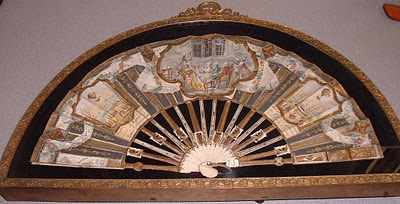The great aeronautical events of December 1, 1783 are commemorated on this beautiful French fan in our collection. What exactly happened 228 years ago, you ask? The first manned ascent in a hydrogen balloon, carried out by Jacques Charles and Nicolas-Louis Robert. The balloon was launched from the Tuileries garden in Paris and traveled 36 kilometers in approximately two hours. Here’s a close-up of the fan, showing the balloon and the observing crowds.
This was only the second manned balloon flight in history, the first having occurred 10 days before in the Montgolfier brothers’ hot-air balloon. Joseph Montgolfier was actually present for the launching of the Charles/Robert balloon, as was Benjamin Franklin, who had also attended the Montgolfier flight. Here is an excerpt from Franklin’s wonderful letter to the British scientist Joseph Banks on December 1:
The morning was foggy, but about one o’clock the air became tolerably clear, to the great satisfaction of the spectators, who were infinite, notice having been given of the intended experiment several days before in the papers, so that all Paris was out, either about the Tuileries, on the quays and bridges, in the fields, the streets, at the windows, or on the tops of houses, besides the inhabitants of all the towns and villages of the environs. Never before was a philosophical experiment so magnificently attended…
Between one and two o’clock, all eyes were gratified with seeing it rise majestically from among the trees, and ascend gradually above the buildings, a most beautiful spectacle. When it was about two hundred feet high, the brave adventurers held out and waved a little white pennant, on both sides their car, to salute the spectators, who returned loud claps of applause. The wind was very little, so that the object though moving to the northward, continued long in view; and it was a great while before the admiring people began to disperse. The persons embarked were Mr. Charles, professor of experimental philosophy, and a zealous promoter of that science; and one of the Messieurs Robert, the very ingenious constructors of the machine.
When it arrived at its height, which I suppose might be three or four hundred toises, it appeared to have only horizontal motion. I had a pocketglass, with which I followed it, till I lost sight first of the men, then of the car, and when I last saw the balloon, it appeared no bigger than a walnut. I write this at seven in the evening. What became of them is not yet known here. I hope they descended by daylight, so as to see and avoid falling among trees or on houses, and that the experiment was completed without any mischievous accident, which the novelty of it and the want of experience might well occasion. I am the more anxious for the event, because I am not well informed of the means provided for letting themselves down, and the loss of these very ingenious men would not only be a discouragement to the progress of the art, but be a sensible loss to science and society.
You can read the entire letter as part of the Internet Modern History Sourcebook at Fordham university.
The French fan also shows the 1784 ascent of Guyton de Morveau. But his story, and his plans for a corps of balloonists during the French Revolution, are tales for another time.


